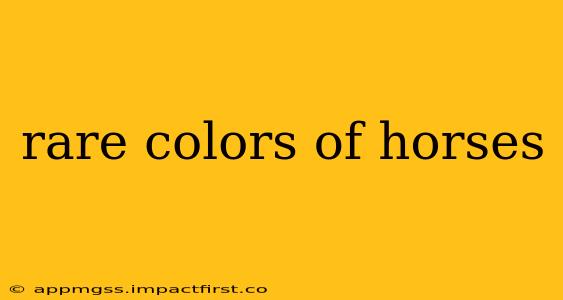The world of horses is brimming with diversity, and a significant part of that diversity lies in their stunning array of coat colors. While some colors like chestnut and bay are common, others are exceptionally rare, captivating horse enthusiasts and breeders alike. This article delves into the fascinating genetics behind these rare hues, exploring some of the most sought-after and visually striking coat colors found in horses. We'll also address some frequently asked questions surrounding these unique equine appearances.
What are some of the rarest horse colors?
Several factors contribute to a horse's coat color, including the interaction of multiple genes. This intricate genetic dance results in a breathtaking spectrum of colors, with some appearing far less frequently than others. Some of the rarest horse colors include:
-
Cream Dilute: This gene doesn't create a color on its own but dilutes existing pigments. In its homozygous form (two copies of the gene), it can create stunning palomino (golden coat with flaxen mane and tail), cremello (almost pure white with pinkish skin), and smoky cream (similar to palomino, but with more muted tones) coats. The rarity stems from the relatively low frequency of the cream gene in horse populations.
-
Champagne: Another diluting gene, Champagne produces a coat that ranges from a pale gold to a deep amber, with a characteristic "champagne" sheen. Its rarity is due to the limited number of horses carrying this particular gene.
-
Dun: Often confused with other colors, the dun gene results in a base coat color with a dorsal stripe (a dark stripe running along the spine), zebra stripes on the legs, and often a primitive marking around the muzzle. While not exceptionally rare in certain breeds, its prevalence varies significantly across different horse populations. The specific shade of dun can also vary considerably.
-
Silver: This is a complex diluting gene, often affecting the black pigment, lightening it to a smoky gray or even blue. Horses with the silver gene often have a distinctive, silvery sheen to their coat. Its rarity is largely due to its relatively recent identification and the complexity of its genetic interaction with other genes.
-
True Black: Ironically, true black is rarer than you might think. Many horses appear black, but genetic testing often reveals they are actually very dark browns or smoky blacks. A true black horse will lack any reddish or brown tones in their coat. The distinction is often subtle, making the identification of true black horses more challenging.
How are rare horse colors determined?
The determination of rare horse colors is a fascinating interplay of genetics. Multiple genes, each with varying degrees of influence, contribute to the final coat color expression. These genes interact in complex ways, leading to a diverse range of phenotypes (observable characteristics). Genetic testing is becoming increasingly sophisticated, allowing breeders and enthusiasts to determine the precise genetic makeup responsible for a horse's unique color. While visual assessment remains important, it's often genetic testing that confirms the true rarity of a particular color.
What breeds are known for rare horse colors?
Certain breeds are more likely to exhibit rare coat colors due to selective breeding practices. For example, the American Cream Draft Horse breed is known for its prevalence of cremello and palomino horses, directly stemming from the breed's deliberate selection for the cream gene. Other breeds, such as the Gypsy Vanner Horse, are known for their variety of colors, including some rare variations of buckskin and dun. However, rare colors can appear in almost any breed, making each horse with a unique coat color a special individual.
Are rare horse colors more expensive?
The cost of a horse is influenced by many factors, including its lineage, training, and overall quality. Rare coat colors can certainly contribute to a horse's value, making them highly sought after by collectors and enthusiasts. However, a horse's price is not solely determined by its coat color. Other traits such as temperament, conformation, and athletic ability play equally important roles.
Do rare horse colors have any health implications?
Generally, rare coat colors themselves do not inherently present any significant health risks. However, certain genes associated with rare colors might be linked to other genetic traits that can have health consequences. For example, some genes that influence coat color might also be associated with increased susceptibility to certain diseases. Careful breeding practices and genetic testing are critical for mitigating any potential health risks associated with particular genes.
The beauty and rarity of unique horse colors continue to fascinate horse lovers worldwide. Understanding the underlying genetics helps us appreciate the complexity and diversity within the equine world. The study of these rare colors is a testament to the ongoing discoveries and ongoing research within the field of equine genetics.
